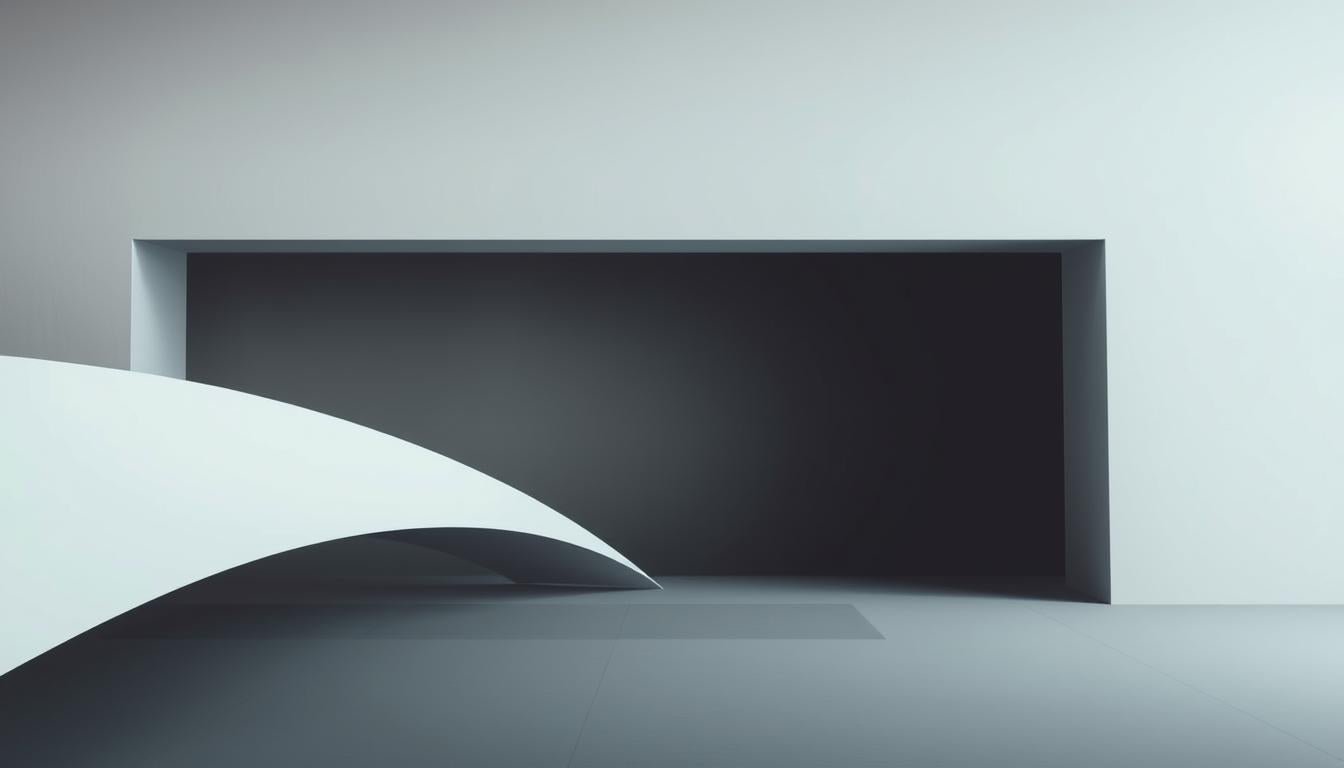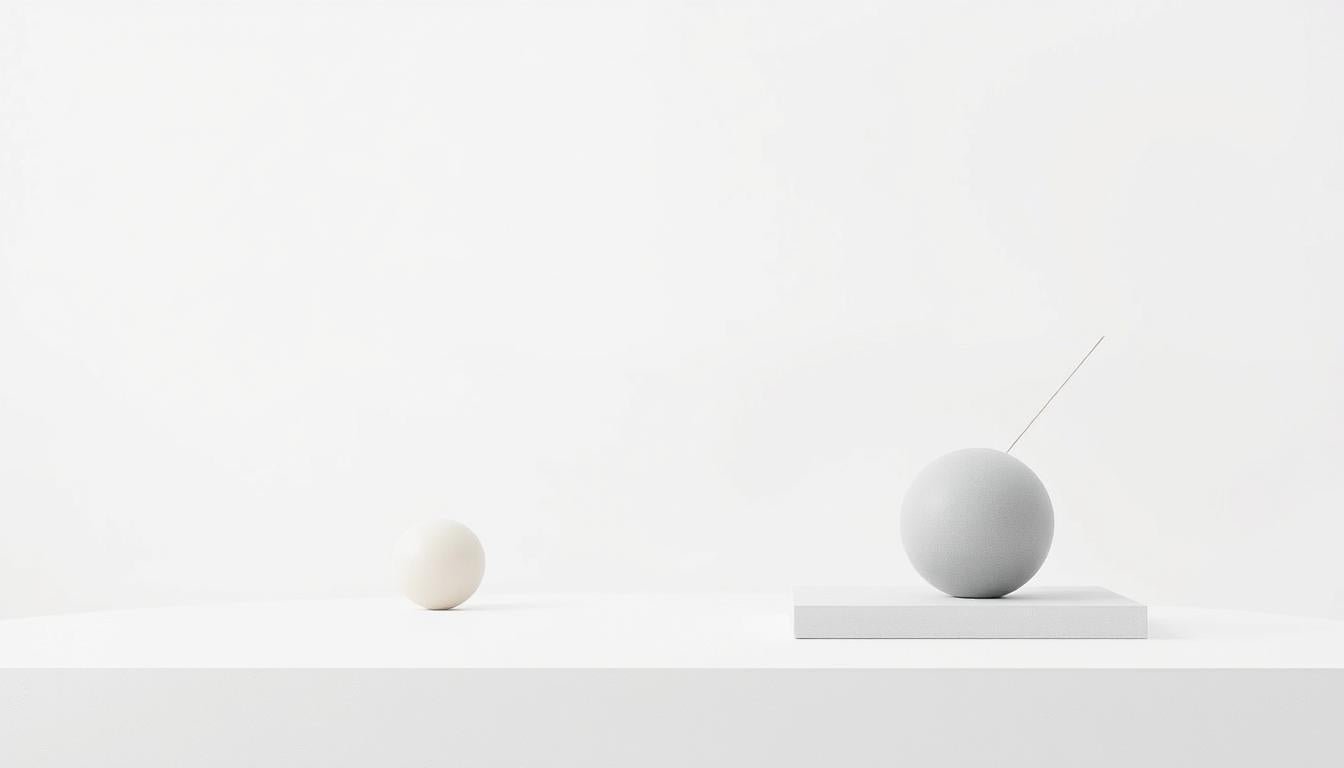"The specific object is not an image." — Donald Judd. This quote frames a shift in how we meet artworks in the world. It invites us to look at materials, edges, and scale rather than stories or symbols.
Minimalism began in the late 1950s and grew in New York through the 1960s. Artists like Frank Stella, Donald Judd, and Agnes Martin pushed painting and sculpture toward simple geometry and industrial materials.
This style foregrounds literal presence over representation. At its core, the idea is clear: what you see is what you see. That clarity changed how the museum and viewers experience works in space.

In this guide you will meet signature qualities—order, harmony, and truth to materials. You will also learn how exhibitions in New York and institutions such as MoMA helped the concept gain momentum.
Key Takeaways
- Minimalist art movement centers on literal presence, not representation.
- It rose in New York and reshaped modern art display and reception.
- Focus falls on materials, scale, light, and simple geometry.
- Notable figures include Frank Stella, Donald Judd, and Carl Andre.
- The style influenced design, architecture, and everyday spaces.
What Is Minimalism in Modern Art?
Minimalism asks viewers to meet the work on its own terms, not as a window onto another world. It grew from abstract art ideas that urged artists to let the piece hold its own reality.
"What you see is what you see."
From abstract ideas to literal presence
Minimalism defines the artwork as an autonomous object: no story, no metaphor, just the medium, edges, and proportions you face. That clarity changes the viewer’s role from decoder to witness.
Geometric forms and the rejection of representation
Simple geometric forms — squares, bands, and crisp rectangles — guide the eye along lines and planes. The choice of medium matters: steel sheets, fluorescent light, plywood or bricks reveal specific properties of the materials.
Minimalist painting favors flatness, repeatable bands, and clean edges so form and optical clarity lead the experience. Artists often used fabrication to reduce visible handwork and keep attention on finish and proportion.
See see the work as it is: the immediacy is not empty. It invites careful looking so subtle shifts in light, reflection, and scale emerge.
Origins and Timeline: From Late 1950s to the 1970s
In the late 1950s a compact group in New York began to rethink scale, surface, and serial form. That time set the stage for a new focus on objecthood and measured composition.
Frank Stella’s Black Paintings at MoMA in 1959 acted as an early flashpoint. These works signaled a move away from gesture and biography toward clear, literal surfaces.
New York beginnings and the 1960s art world
The 1960s were a period when artists refined abstraction into direct, unembellished pieces and sculpture-like objects. Museums and young galleries in new york helped these ideas gain traction.
From museum shows to wider recognition in the U.S. and Europe
Museum modern art platforms — MoMA, the Jewish Museum, key exhibitions and publications — moved the work from studios into public debate.
- Growth paralleled conceptual art, sharing questions about the art object's status.
- Curators, dealers, and journals created a fast network that carried ideas across the world.
- By the 1970s the language had wide recognition and serious debate in both the U.S. and Europe.
"What you see is what you see."
Legacy: The timeline shows how quickly a focused idea reshaped the modern art scene and prepared the ground for signature artists and defining characteristics.
Key Characteristics of Minimalist Art
Look closely: squares, grids, and repeated modules shape how these works speak to a room. The visual language favors clear geometric forms that point attention to structure instead of image.
Simple geometry and repeated units
Squares, rectangles, and serial bands create visual clarity. Repetition makes rhythm and lets proportion become the message.
Industrial materials and prefabrication
Artists used steel, fluorescent light, plywood, and bricks to foreground surface and weight. Smooth finishes and fabrication remove visible gesture so the materials read plainly.
Objecthood, scale, and space
Each piece exists as an object in a room, affecting how you move and look. Scale and sightlines make shadow and reflection part of the experience.
Order, harmony, and truth to materials
The style prizes order and calm precision. Letting steel look like steel or plywood like plywood becomes the work’s content. Strict lines and edges in painting keep focus on the plane and its limits.
Friendly takeaway: Simplicity is a method, not a shortcut. The rigor lies in form, proportion, and how the work alters the feel of a room.
Pioneering Artists and Signature Works
A handful of creators gave form to an exacting visual language that still shapes galleries today.
Frank Stella: Black Paintings
Frank Stella used commercial black paint and rigid bands in the Black Paintings (1958–60). These paintings declared "What you see is what you see" and pushed against abstract expressionist ideas about gesture.
Donald Judd: stacks and primary structures
Donald Judd made wall-mounted stacks and "primary structures" from brass, Plexiglas, and industrial materials. His repeated units and exacting fabrication erased the visible hand and made each object autonomous.
Sol LeWitt: systems and series
Sol LeWitt turned cubes and grids into modular rules. His serial approach used instructions to produce large, systematic works and extend the idea of series across space.
Robert Morris, Carl Andre, Dan Flavin, Agnes Martin
- Robert Morris made mirrored cubes that fold viewers into the piece, altering perception of space.
- Carl Andre placed metal plates and bricks at floor level (Lever, 1966) to treat the ground as sculpture.
- Dan Flavin used fluorescent tubes to shape color and atmosphere, making light itself a material.
- Agnes Martin drew subtle grids and lines to create calm, meditative paintings.
These artists worked in New York studios and galleries where debates about form, fabrication, and perception fueled new series-based thinking. Their collective works reframed painting and sculpture as precise, serial, and spatial practices that still influence artists and exhibitions today.
For more on the pioneers, see a concise roster of minimalist artists and pioneers.
Landmark Exhibitions and Institutions
In 1966 one show in New York reframed industrial finish and modular forms for wider audiences. Museums began to treat prefabricated, factory-finished objects as serious work rather than mere design experiments.
Primary Structures (1966) at the Jewish Museum
Primary Structures brought together Sol LeWitt, Donald Judd, Dan Flavin, Robert Morris, Tony Smith, and others. The exhibition showcased bare, industrial pieces and serial modules that foregrounded surface and scale.
The show sparked debates about authorship. Critics asked whether designing a piece and having it fabricated still counted as the artist’s work.
MoMA and the rise of museum modern art
Earlier museum shows, including Frank Stella’s Black Paintings at MoMA, set the stage for broader institutional acceptance. New York museums and curators legitimized the approach within museum modern and modern art contexts.
Curators, dealers, and critics then amplified these ideas through catalogs, essays, and traveling exhibitions. That network helped move works across the U.S. and Europe.
"The gallery itself became part of how a work was seen."
- Exhibition model: clean installations, standardized modules, precise lighting.
- Key participants: Judd, LeWitt, Morris, Flavin, Smith—each showing different takes on serial form.
- Legacy: museum practices still emphasize spacing and architectural care when showing these works.
Influences and Crosscurrents
A network of earlier ideas fed the new clarity: painters and sculptors borrowed scale, systems, and industrial logic from past experiments.
Dialogues with abstract expressionism and Color Field painting
The response was direct. Artists rejected abstract expressionist biography and visible gesture. They still learned from Color Field painters about scale and flatness.
Frank Stella pushed finish and edge instead of personal mark, so paintings turned toward literal surface and reduced drama.

Russian Constructivism and Suprematism: modularity and production
Early 20th-century experiments supplied clear precedents. Constructivism and Suprematism suggested modular design, factory production, and pure form.
Donald Judd wrote on Malevich, and Robert Morris cited Tatlin and Rodchenko as direct debts.
Conceptual art’s shared challenge to the art object
Marcel Duchamp’s readymades legitimized prefabricated components and detached authorship from handwork.
Dan Flavin’s Homages to Vladimir Tatlin show explicit dialogue with those legacies.
At the same time, conceptual art paralleled these changes by questioning the aura and status of the work.
- Contrast: cool restraint replaced gestural expressiveness.
- Scale: Color Field teachings shaped large, flat planes.
- Production: Constructivist ideas supported modular, industrial logic.
"What you see is what you see."
Friendly takeaway: This style did not spring from nowhere. It is a conversation across time that blends historical experiments with a new, impersonal register. Understanding those roots clarifies why works favor clarity, repetition, and factory finish.
Materials, Media, and Methods
The materials themselves became the starting point for how pieces were shaped and shown. In the 1960s artists favored an industrial palette that made medium the message.
Steel, fluorescent light, plywood, bricks: the industrial palette
Steel reads as weight and sheen; its edges catch light and define form. Fluorescent light spreads cool color across a room—Dan Flavin used standard tubes so light, not paint, became the work. Plywood shows grain and joinery, while bricks give modular heft and rhythm like Carl Andre’s floor pieces.
Fabrication, repetition, and series as a way of working
Artists often delegated fabrication to keep finishes uniform and precise. Donald Judd used prefabricated metals and Plexiglas in repeated modules to erase visible handwork.
Series and repetition let small shifts in spacing or scale change rhythm and reflection. The result is work that reads as both object and architecture.
"The medium is the subject: light filling a corner or steel catching shadow."
Friendly tip: Walk around these pieces. Look down at gaps and up at seams. Simple parts combine to reshape a room and reveal how method equals meaning.
Painting, Sculpture, or Object? Blurring the Boundaries
Artists began treating paintings as things and sculptures as spaces, so labels mattered less than effect.
Painting shifted toward objecthood: thicker supports, emphasized edges, and repeated planes made canvases project presence rather than illusion. Frank Stella’s works show how a flat surface can feel like a literal object in the room.
Sculpture left the pedestal. Floor pieces and wall-mounted modules claimed the gallery as part of the piece. Robert Morris’s mirrored cubes and Dan Flavin’s light installations force you to move around them.
Donald Judd called many pieces “primary structures.” These hang like a painting yet assert three-dimensional volume. The result is a steady blurring between two media.

The era rejected strict rules about medium purity. What mattered was form, edges, and intervals. Whether called painting or sculpture, the focus rested on precise spatial relationships.
| Type | Typical Placement | Effect on Viewer |
|---|---|---|
| Painting as object | Wall, projecting | Heightens presence, frames edge |
| Wall-mounted structures | Wall, offset | Blurs 2D/3D, adds volume |
| Floor pieces | Gallery floor | Invites movement, changes sightlines |
Think less in categories and more in how a piece changes perception. That shift was central to the movement’s clear, honest presentation of the work.
Experiencing Minimalist Art in the Gallery
Walking a gallery with clean, precise pieces asks you to change the way you move. The experience is physical: scale, gravity, and placement work together to shape perception.
Scale, gravity, and the viewer’s movement in space
Slow down and walk the room. Move left, right, and back. Small shifts reveal how a line of elements can redirect traffic and alter sightlines.
Carl Andre’s Lever — a row of 137 firebricks — shows how a simple line can reframe a floor and guide people around it. Robert Morris’s mirrored cubes fold viewers and surroundings into the piece, making perception part of the work.
Dan Flavin’s fluorescent constructions act like colored objects that flood corners and corridors. Notice how light behaves as material and changes the room’s mood.
- Trace a path that meets each sculpture from multiple angles.
- Pay attention to edges and intervals; gaps often carry meaning equal to the units.
- Compare works in the same room to feel how height, spacing, and finish change tone.
"The best way to see see this style is to move—look close, step back, and let light and shadow settle."
Tip: Stand still after circling a piece. The quiet, bodily attention is how these works reveal themselves. For a short guide to the history that frames these experiences, see the history of minimalism.
Legacy, Post-Minimalism, and Contemporary Impact
The era's insistence on structure and finish left a durable imprint on museums, studios, and homes.
By the late 1970s, minimalism had secured a place in America and Europe through curators, dealers, and patrons. Its clarity, repetition, and fabrication methods reshaped the world of exhibition and collection.
From reaction to reinvention
Post-Minimalism responded by keeping the lessons of form while testing process and pliable materials. Artists explored bodily presence and provisional systems that pushed beyond pure geometry.
- Design and architecture: clean lines, honest materials, and efficient layouts moved into daily life.
- Museum modern practice: major institutions continue to collect and display Donald Judd, Sol LeWitt, Dan Flavin, and Agnes Martin.
- Ongoing practice: contemporary artists organize series and systems to test abstraction across time.
Conceptual art rose alongside these changes, widening what counted as work—from instructions to installations. New York kept a central role in shaping debates about materials and display.
"The idea of an artwork—its structure, arrangement, and context—became as important as any image."
Friendly takeaway: The lasting power of minimalism lies in how it refines attention. Rooms, objects, and light feel newly present because the period taught people to value simplicity without losing depth.
Conclusion
Order, harmony, and truth to materials remain at the heart of this concise legacy. The minimalist art movement distilled painting and sculpture to clear forms, precise finishes, and careful placement.
We traced origins, key artists, landmark shows, materials, and the gallery experience. The period blurred categories so a single work could read as painting, object, or sculpture.
Minimalism invites viewers to slow down. Notice lines, edges, and scale. Let proportion and placement, not narrative, guide your attention.
Revisit Stella, Judd, Flavin, Andre, Martin, and others in person when you can. Their spare vocabulary still shapes design and keeps abstraction alive as a powerful way of seeing.
Enhance Your Space with Unique Modern Masterpieces by Chiara Rossetti
Are you inspired by the innovative mediums and conceptual depth highlighted in our exploration of contemporary art? You’re not alone! Today’s art enthusiasts are seeking cultural relevance and emotional connections in their artwork. However, finding pieces that resonate with modern themes and fit your unique style can be a challenge. That’s where we come in!
At Rossetti Art, we specialize in canvas prints, original paintings, and modern sculptures that celebrate the spirit of now. Each piece created by Chiara Rossetti brings a personal touch that connects deeply with current social narratives—just like the modern masterpieces discussed in the article. Don’t miss out on the chance to elevate your home decor with breathtaking artwork that speaks to your values and aesthetic. Explore our collection today and find your perfect piece! Act now, and transform your space into a gallery of inspiration!
FAQ
What defines the minimalist art movement?
Minimalist work favors simple geometric forms, clean surfaces, and reduced color. Artists focused on objecthood, scale, and the materials themselves rather than narrative or overt symbolism. The goal was clarity: remove excess and let material, shape, and space speak.
How did minimalism differ from Abstract Expressionism?
Unlike Abstract Expressionism’s gestural, emotive approach, minimalism emphasized order, restraint, and often industrial fabrication. Where painters like Jackson Pollock celebrated individual gesture, practitioners such as Donald Judd and Frank Stella prioritized repetition, seriality, and visual economy.
When and where did this style emerge?
The trend took shape in late 1950s and early 1960s New York and gained national and European recognition through the 1960s and 1970s. Key exhibitions and museum support helped move it from studio experiments into major public collections.
Who are the leading artists associated with this approach?
Prominent figures include Donald Judd, Frank Stella, Sol LeWitt, Dan Flavin, Robert Morris, Carl Andre, and Agnes Martin. Each explored geometry, material honesty, and serial production in distinct ways—ranging from Flavin’s fluorescent works to LeWitt’s concept-driven systems.
What materials and methods are common?
Artists used industrial media like steel, plywood, bricks, and fluorescent light. Prefabrication, fabrication by fabricators, repetition, and series became common methods, emphasizing object presence over visible brushwork or handcrafting.
Are these works paintings, sculptures, or something else?
Many pieces blur categories. Some look like pared-down paintings; others function as freestanding objects or installations. The emphasis is on the viewer’s experience of form, scale, and placement rather than fitting into traditional labels.
Which exhibitions helped establish this style in museums?
Shows like Primary Structures (1966) at the Jewish Museum in New York were pivotal. Museum acquisitions and exhibitions at institutions such as the Museum of Modern Art later reinforced the style’s prominence in the modern collection.
How did earlier movements influence it?
It drew on Color Field painting’s flatness and Russian Constructivist ideas about geometry, modularity, and production. Conceptual art also influenced the emphasis on idea and system over painterly content.
What is the relationship between minimalism and post-minimalism?
Post-minimalist artists retained the formal clarity but reintroduced process, organic materials, and expressive gestures. The later work often examined systems and materials while opening to subjectivity and varied techniques.
How should visitors experience these works in a gallery?
Move slowly and pay attention to scale, light, and spatial relationships. Many pieces depend on the viewer’s movement; distance, angle, and proximity change how forms read. Quiet observation reveals subtle choices in proportion and finish.
Where can I see important examples today?
Major museums such as MoMA, the Whitney Museum, Tate Modern, and the Menil Collection hold important examples. University collections and specialized foundations—like the Judd Foundation—also preserve key installations and archives.







Leave a comment
This site is protected by hCaptcha and the hCaptcha Privacy Policy and Terms of Service apply.